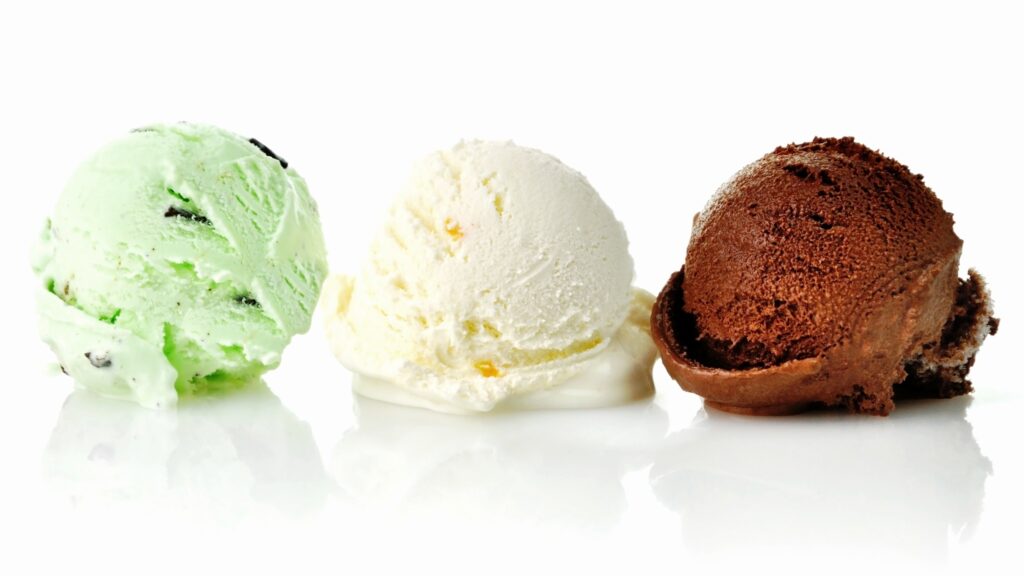You may already know of each of these dairy-based frozen desserts, but what’s with the different names for three sweets that each appear to be fundamentally the same? What are the differences between custard and ice cream and, actually, aren’t gelato and custard one and the same?
Get out that ice cream maker and don your snow boots because we’re spending a little time out in the cold for a full frozen dessert breakdown! We’ll answer these questions and more, covering everything you need to know about ice cream vs. custard vs. gelato.
What is Ice Cream?

Let’s start with the sweet treat that is likely most well-known to most folks: ice cream! Most ice cream recipes are quite simple, with a basis of cream, sugar, and any flavorings or mix in’s. Some homemade ice cream or small batch producers choose to include egg yolks for thickness, while larger commercial ice cream makers may incorporate natural gums or carrageenan to promote cohesivity throughout the product and that wonderfully thick mouthfeel.
Another unique characteristic of ice cream is the amount of air that is whipped into it during freezing, also known as overrun. Ice cream contains a significant amount of overrun, sometimes as much as 100% meaning that 2 cups of ice cream base could become a full quart of ice cream after it is whipped and frozen!
Due to the way that ice cream is mixed–and the amount of air that is incorporated–as it freezes, ice cream tends to feature ice crystals which are quite large, giving the finished product a light, fluffy texture. This type of ice cream is often referred to as “American Style” ice cream in other countries, due to the fact that alternate base ingredients and churning methodology are typically employed elsewhere.
FDA Regulations That All Ice Cream Must Meet
Yes, odd as it may seem, ice cream is a product regulated by the Food and Drug Administration. Due to the fact that ice cream contains a significant amount of air, the regulations are in place in order to prevent manufacturers from duping customers into purchasing ice cream products that have extremely high air content–and charging full price for it!
Here are the key standards that any frozen dessert must meet in order to be labeled “ice cream”:
- Ice cream must contain at least 10% fat.
- If the ice cream contains egg, it must be less than or equal to 1.4% of the total volume.
- Ice cream may contain up to, but not greater than, 100% overrun.
- To support the overrun limitation, there is also the regulation that any ice cream must weigh at least 4.5 pounds per gallon of volume, of which 1.6 pounds of that weight must consist of solids.
What is Gelato?

If you’re familiar with a few Italian words, you’ll get a big hint as to the nature of gelato, seeing as the word itself translates to “frozen”! Rather than being cream based, gelato typically contains more milk and little or no egg yolk, meaning it also tends to contain less butterfat as compared to other frozen dairy dessert products.
Without that rich heavy cream or any emulsifying egg yolks, it may seem a wonder that gelato still manages to have such a rich, creamy texture. Amazingly, this consistency is simply achieved by the churning process, during which only a small amount of air is allowed to incorporate into the gelato. Most gelatos feature about 30% overrun, but of course this can vary from producer to producer and batch to batch.
Characteristics of Gelato
Whereas ice cream is regulated and standardized, gelato actually has no particular standardization requirements to meet. This can be both a good thing and a bad thing, as it allows gelato makers a bit more freedom to craft and experiment with their frozen treats. But on the other hand, it also doesn’t stop manufacturers from slapping an “Italian gelato” designation on any frozen dessert, whether or not it actually meets the typical expectations one might have of such a product.
That said, there are some basic characteristics that most gelato products meet, and that most folks come to associate with this version of a frozen dessert:
- Most gelatos contain somewhere between 4%-9% milk fat, due to the fact that they are made from milk as opposed to cream.
- Spreadability is a defining characteristic of gelato, as the relatively low air content and small ice crystallization helps to keep this product smooth as opposed to freezing hard.
- Gelato tends to be served warmer than other frozen desserts. Just a few degrees of added warmth is enough to improve one’s experience of flavor, and the unique density of gelato helps it to resist melting under the warmer conditions.
What is Custard?

Frozen custard, known colloquially as “custard” (not to be confused with the sweet, creamy, un-frozen pudding-style dessert of the same name!) is said to have been invented one hot summer day on Coney Island. A pair of ice cream vendors discovered that by adding eggs to their product, it would be denser and richer, and most importantly, stay cold longer. This was ideal for their eager customers who purchased their frozen treats and then proceeded to enjoy them as they wandered about the boardwalk.
From this origin point, the joy of frozen custard began spreading and custard stands started popping up everywhere. One place you won’t find frozen custard, however, is your local grocery store. This is because frozen custard is best enjoyed straight away, as tossing it into a freezer would alter the special smooth and creamy texture of this treat–essentially destroying what makes frozen custard, well, frozen custard!
Frozen Custard Specifics
There are a few FDA regulations that apply to custard, mainly to dictate where the line is drawn between custard and ice cream. In addition to these guidelines, there are also several general expectations that most people have when it comes to their scoop of frozen custard!
- As per the FDA, eggs are mandatory on the ingredients list! For any product to be called frozen custard, it must contain at least 1.4 percent egg yolk.
- Like ice cream, frozen custard must also contain at least 10% milk fat.
- There are no regulations on overrun for frozen custard, but most frozen custards contain only around 20% air content.
- Due to the inclusion of eggs on the ingredients label, folks expect frozen custard to have a rich, eggy flavor and dense, thick consistency.
Key Differences Between Ice Cream, Gelato, and Custard

Now that we understand the basics of these classic frozen sweets, let’s review the key differences between the three.
Ingredients:
All three of these products contain the same base ingredients with a few minor differences. Ice cream is made from cream and/or milk, sugar, and sometimes a small amount of egg yolk. Gelato features less cream and is more milk based, but it typically does not contain eggs. Frozen custard may be made from either cream, milk, or a combination of both.
While both ice cream and gelato may contain eggs, custard is the only product which must contain egg yolks.
Air Content:
When it comes to ice cream vs. gelato vs. custard, one major difference lies in the amount of air whipped into each product as it freezes.
Ice cream contains more air than either gelato or frozen custard, sometimes up to 100%–but never more than that. Frozen custard generally contains a bit less air content than gelato, which hovers around 30%, however these two products are about on par with one another in the overrun department.
Taste & Texture:
As you might expect from having some different ingredients and air content, there are of course some key differences in how these three products hit you in the taste buds! American ice cream tends to be light, fluffy, and rich thanks to the inclusion of cream.
Gelato has a velvety texture due to its density, but it is lighter in flavor and more milky in taste as opposed to butterfat-laden. It also credits a bit of its rich flavor to the fact that it is served at a slightly warmer temperature as compared to the other frozen desserts. Frozen custard has a similarly thick consistency, but with a noticeably eggy flavor and emulsified texture.
Regionality:
These three frozen confections experience some differences in terms of where and how they are each consumed! It’s no secret that ice cream is the standard American treat, although it is readily enjoyed in many other parts of the world as well. As an Italian classic, Gelato tends to be most popular across Europe, while frozen custard is a regional favorite in some areas of the United States, namely New England and the Midwest.
Availability:
It’s also worth noting that ice cream is the only one of the three that you’re likely to find packed and sold in the freezer section of a supermarket, whereas you can really only get gelato and frozen custard in their truest form from a gelateria or frozen custard stand.
Nutritional Makeup:
Seeing as each of these products tends to come in a variety of delicious flavors, which may or may not dramatically alter the nutritional profile of the dessert itself, it’s tough to give a blanket statement of one that is healthier than the other.
Generally speaking however, ice cream will contain more milk fat than either gelato or custard, while gelato will contain fewer calories. Frozen custard also tends to have more protein than the other two options thanks to the inclusion of those eggs!
A Few Other Frozen Treats Worth Noting

- Soft Serve: made with milk, this frozen treat stays a bit warmer as a churns, keeping it soft!
- Frozen Yogurt: an ice cream-like dessert which contains yogurt (or sometimes just yogurt cultures) in place of some milk or cream ingredients to give it that tangy taste.
- Frozen Dairy Desserts: any frozen confection labeled “frozen dairy dessert” will possess many of the same characteristics as ice cream but does not meet the technical requirements to be labeled as such.
- Dairy Free Desserts: there are many dairy free dessert options out there these days, from tasty coconut cream based options to those made from almond milk, soy milk, cashew milk, and more!
Comparing Ice Cream vs. Gelato vs. Frozen Custard: The Takeaway
Now that you’re an expert on the similarities and differences between ice cream, gelato, and frozen custard, it’s time to get out there and enjoy your newfound knowledge! Treat yourself to a scoop of vanilla ice cream, or get to work tracking down a traditional custard stand in your area or an authentic gelato shop at your next vacation spot.
Looking for some other frozen goodies in the meantime? Check out these 30 foods that taste even better frozen or get cold and crafty with these 15 creative ways to use your ice cube trays.